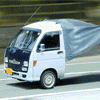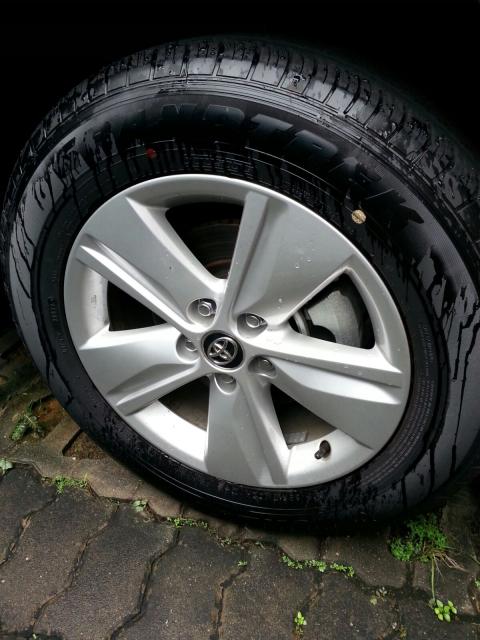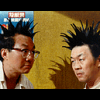Search the Community
Showing results for tags 'ORIGINAL'.
-
anyone has done original ecu programming - got a leaflet advertising this from harmony motor pte ltd - tune by joey. for hyundai / chevrolet/ssyong/proton/mitsubishi and kia see www.harmony.sg wonder anyone has done it and is there real improvement to fuel consumption and performance and will it screw up the ecu ? rgds
-
https://www.wired.com/story/netflixs-hyperdrive-american-ninja-warrior-cars/ Lol I'm watching it now.
- 3 replies
-
- hyperdrive
- netflix
- (and 5 more)
-
Hi Guys, Just came bk from a sparepart shop n bought another 6 pcs of oil filter for my car. All along, i always buy original toyota oil filer but today, I changed my mind and get someting cheaper- Denso oil filter. Some of you may know that that Toyota oil filter is manufactured by Denso and i dont think that there is any different between denso filter vs toyota filter since it is manufactured by the same company. But the price is 23% cheaper for OEM parts (toyota filter 6.50, Denso filter $5.00) So, why r we spending more for original instead of OEM parts?? any comment guys??
-
Hello all, Just to seek some opinions and advise from MCF members and experience professional. I've just committed to an AD for a new car, and here comes my dilemma... The car comes with a 18' matte/silver colored rims and I do not like the color. I've always been fan of shinny chrome rims as it is easy to clean and wash daily. Is it advisable to purchase a new set of chrome rims (same size 18') and use back the tyres, or it is better to keep the OEM rims and have them chromed so that the performance is not wrongly compromised by the newly purchased chrome rims? If the latter is true, then where in SG can get this service for chroming the rims? TIA
- 132 replies
-
- mercedes-benz
- rims tyres chrome
-
(and 7 more)
Tagged with:
-
Any one know of any car shop that can get the original rims? Thanks
-
Hi all, I'm new to this forum.. I want to trade in my new Totoya Harrier 17" rims & tyres. Any recommendation where to do it?
-
I mean looking at it on the car itself. Or must take out and see from the inside? Any telltale signs that can split them apart?
- 44 replies
-
- Tell
- Aftermarket
-
(and 2 more)
Tagged with:
-
Hi all, I am looking for a new or almost like new condition, original 19-inch rims (with original tyres) for the 2016 Mazda CX-5. If anyone is keen to sell them or has come across them at any rim and tyre shops in Singapore, pls let me know. Thank you. Wishing all here a happy New Year's Eve and a peaceful 2016
-
Guys, any recommendation where to buy & how to tell if original? What shud be the price? So many online sellers now selling between $50 to $70. Are these real or replicas?
-
So you went to your trusted workshop with good reputation to get your major servicing done. You were assured that only original parts were used including original BMW spark plugs. You paid the 4 figures bill and left. About 1 year and tens of thousand miles later, you went to another workshop to do another major serving which includes checking spark plug and change if necessary. The mechanic sent to you a picture of the spark plus via Whatsapp. You almost fell off the chair because you realized that you have been cheated by the first workshop. The spark plugs were OEM not original. What would you do or what can you do?
- 47 replies
-
- 1
-

-
- bmw
- spark plugs
-
(and 2 more)
Tagged with:
-
Do people still play with Nintendo Wii nowadays? We are doing some spring cleaning, lo and behold, I got so many original used games! I have since disposed of my Wii (I think it stopped working). Do people still play the Wii nowadays? (Also got 2 XBOX 360 games)
-
Hi. I am looking for original VW Golf 17" rims. Know any shops that might carry these? Don't mind those that are traded in as long as good condition. Thanks!
- 1 reply
-
- volkswagen
- looking
-
(and 3 more)
Tagged with:
-

Smile Inc Dental Surgeons Pte Ltd - The Original Since 1997
LifePro_Tips posted a topic in Lite & EZ
Smile Inc Dental Surgeons Pte Ltd With an established chain of dental practices in Singapore, DENTAL SURGEONS has garnered yet another feather in its cap with its opening of Asia’s leading premium boutique dental practice of its kind at the Mandarin Gallery, Orchard Road, Singapore, in 2010. This beautiful set up offers the latest technologies in a modern-luxe meets timeless chic setting, and offers patients the coolest retreat to seek the most up to date smile makeovers. Boasting the latest technologies - such as the Cone Beam CT scanner for radiographs and dental scans – to state of the art décor, coupled with the skilled expertise of its range of specialists headed by DR. ERNEST REX TAN, DENTAL SURGEONS at Mandarin Gallery offers rewarding patient experiences, and has been hailed by both patients and foreign visitors as “the future of dentistry”. “Taking Dentistry in Singapore to Yet Another Platform” is what its patients say about DENTAL SURGEONS at Mandarin Gallery. Dental Surgeons was started in 1997 with the vision of making Singapore the Dental Hub of the region. The name, itself at that time was already an indication of a distinct and modern dental facility, and one that provided high quality dental care and services, and utilizing the latest techniques and state-of the art technology and facilities. This, amid a patient-friendly setup which will allay any fears of visiting the dentist at value for money charges. Its main practice began operations at Suntec City Mall in 1997. The business model and the philosophy of providing value-added dental care was so well received that within a year, Smile Inc.â Dental Surgeons was invited to start a second practice at Forum Mall in 1998.* The setup at One Raffles Quay in 2007 was in response to its patients’ requests as their offices had moved to the new downtown, while the latest dental boutique concept was set up at Mandarin Gallery in 2010. *Our practice at Forum Mall has since been relocated to Mandarin Gallery in 2010. has developed many breakthrough systems and concepts that have caught the eye of the public and these have been featured in numerous publications. Founder & Director Dr. Ernest Rex Tan Specialist in Prosthodontics B.D.S. ( Singapore ) M.Sc. Restorative Dentistry ( London , U.K. ) Dr. Ernest Rex Tan , Co-Founder and Director of Smile inc. Dental Surgeons , embarked in dental career after graduating from the National University of Singapore in 1991 , and the renowned postgraduate Masters program in Restorative Dentistry from the Eastman Dental Institute in London , UK , in 1994 . This training provided Dr. Tan a firm foundation in managing the many complex reconstructive and cosmetic challenges that his patients present. This together with years of transforming and beautifying smiles , has resulted in his acquiring the expertise , experience and artistic creativity required to perform predictable , consistent and successful Smile Makeovers with exceptional cosmetic outcomes. Dr. Ernest Rex Tan is today a key Prosthodontist in Singapore . He started Smile inc. Dental Surgeons , a household name in the dental industry , and is the first and only dental surgeon in Singapore to perform ( and popularise ) the revolutionary Britesmile Laser Teeth Whitening procedure since 1997. Dr Ernest Rex Tan is also an authority in the field of cosmetic dental work , having branded the hallmark of his procedures , Smile inc Makeover since 2004 . Dr Tan and his practice have been featured in many publications in the media for their innovations and advance in cosmetic dentistry. Contact Us Marina Bay – the Sail 2 Marina Boulevard #01-02 Tel : 6222 2900 Website : www.smileinc.com.sg Mandarin Gallery 2 333A Orchard Road #04-18 Tel : 6733 0660 Website : www.smileinc.com.sg One Raffles Place 1 Raffles Place #01-61 Tower 2 Tel : 6636 1366 Website : www.smileinc.com.sg -
http://yawningbread.wordpress.com/2013/10/27/one-quarter-of-singapore-households-below-poverty-line/ Menu One quarter of Singapore households below poverty line Source: Key Household Income Trends 2012, by Dept of Statistics Source: Key Household Income Trends 2012, by Dept of Statistics Minister for Social and Family Development Chan Chun Sing ruled out having an official poverty line. He was speaking in reply to Non-constituency Member of Parliament Yee Jenn Jong (Workers Party). Chan said it would not fully reflect the severity and complexity of issues faced by the poor, and may also lead to needy persons who happen to be above the line missing out on assistance. The full text of the question and written parliamentary reply is as follows: Parliamentary sitting, 21 October 2013 Question by Yee JennJong: To ask the Minister for Social and Family Development whether the Government plans to introduce an official poverty line adapted from international practice to identify at-risk households and to measure the performance of governmental and non-governmental efforts in helping them leave the poverty cycle. Written Answer by Chan Chun Sing, Minister for Social and Family Development: Different countries tailor their methods to identify and assist their needy according to their circumstance. Even amongst developed countries, New Zealand and Canada do not subscribe to official poverty lines. In Singapore, we use broad definitions for the groups we seek to help, have clear criteria to identify and assess those in need, and tailored schemes to assist them. A poverty line does not fully reflect the severity and complexity of the issues faced by poor families, which could include ill health, lack of housing or weak family relationships. If we use a single poverty line to assess the family, we also risk a cliff effect, where those below the poverty line receive all forms of assistance, while other genuinely needy citizens outside the poverty line are excluded. Our assessment process is rigorous but also flexible to cater to the genuinely needy. Singaporeans who do not meet scheme criteria but who still deserve help, can receive assistance. Link to press release at Ministry of Social and Family Development website Social media tore at the cliff effect that he mentioned. And rightly so. Look carefully at Yees question. He was suggesting that having an official poverty line would do two things: identify at-risk households and provide a convenient longitudinal gauge of the effectiveness of policy intervention. He did not say that a poverty line is all that is needed to fully reflect the severity and complexity of the issues, nor did he suggest that those below the poverty line receive all forms of assistance, while other genuinely needy citizens outside the poverty line are excluded. Chan Chun Sing Chan Chun Sing Chan Chun Sing twisted the question into this form in order to knock down the idea. This is not engagement. It is contortion and misrepresentation in order to avoid engagement. A good government will always have a multiplicity of help schemes for the poor and underprivileged. Each help scheme will have its own set of eligibility and means-testing criteria, simply because each help scheme seeks to address a specific need. But precisely because theres a multiplicity of programmes, each with varying criteria, it becomes too complex for the public to have an easy grasp of whether were moving forwards or backwards. A simple measure like a poverty line is a rough indicator but a useful one to know how were doing. Nobody is suggesting that it becomes the only criterion for receiving state support; nobody is arguing for a cliff effect. Secondly, a poverty line helps direct resources a little better. Without it, theres a tendency to sit back and say, we have all these schemes and its up to the indigent folks to approach us for help. The reality is that the indigent also tend to be cut off from information because of economic deprivation. Having an at-risk indicator like a poverty line helps social help providers to know who they should pro-actively approach with the possibility of offering help. Which doors should we knock on? Chans answer reinforces a general view about this government. They really do not want to provide social assistance. At heart they really do believe in trickle-down and little else. They only get into social assistance when they cant avoid it and a problem is staring them in the face. More effort is spent trying to excuse themselves from doing anything, rather than propel themselves to deliver assistance. Twisting Yees words in order to avoid accepting the value of having an official poverty line is entirely consistent with this governments character. Undoubtedly, they are afraid that once an official poverty line is drawn, the ineffectiveness of existing social support becomes clearer, with at-risk numbers refusing to budge year after year. Public pressure to do more becomes hard to resist. Doing more, however, is not what the government wants. How about using the same formula as Hong Kong for a poverty line? Nothing should stop civil society from arriving by consensus at a poverty line. If the government wont set one, well derive our own. Used repeatedly over time, it will gain acceptance as a measure of our societys social wellbeing. The easiest, especially if we want comparability, is to follow Hong Kongs definition. Carrie Lam Carrie Lam So first, we need to understand how Hong Kongs official poverty line is set. Let me quote Chief Secretary Carrie Lams statement: The poverty line is defined as half of the median monthly household income of all domestic households in Hong Kong, prior to government intervention like tax and social benefits transfers. This approach is based on the concept of relative poverty as opposed to absolute poverty expressed in terms of basic subsistence. The commission considers that in an affluent city like Hong Kong, poverty can no longer be understood merely by the lack of ability to afford minimum subsistence. Relative poverty acknowledges that the definition of poverty should move with the times and change with general living standards. This is in line with the current Governments thinking that we should put in place a reasonable and sustainable social-support system where different strata of society can share the fruits of economic development. For 2012, the poverty line was $3,600 for a single person, $7,700 for a two-person household, $11,500 for a three-person household, $14,300, $14,800 and $15,800 for a family of four, five and six & above respectively. These poverty thresholds will be reviewed annually in line with the median monthly household income movement. Statement from Hong Kong Information Services Department, 30 September 2013, link: http://www.news.gov.hk/en/record/html/2013/09/20130930_110325.lin.shtml The statement continues, cautioning readers to be conscious of the limitations of such a simple, broadbrush measure: While easy to understand and comparable to international and local practices, the income-based poverty line has its limitations. Specifically, the median monthly household income measures only income without considering assets. Some asset-rich, income-poor people, such as better-off elderly people or retirees, may be classified as poor, thus overstating the poverty problem. Given the relativity concept, poverty cannot be eliminated. Indeed, an economic upturn with a broad-based improvement in household income does not guarantee a decrease in the size of the poor population, especially when the income growth of households below the poverty line is less promising than the overall. There will always be people below the poverty line. ibid When we try to use the same definition as Hong Kong to derive a poverty line for Singapore, we immediately run into problems. Firstly I am unable to establish how income is defined in Hong Kong for their household income survey and for the purposes of poverty line calculation. Some tables from Hong Kong Statistics (e.g. in this report: Household income distribution in Hong Kong) appear to use the term income from main employment; other tables just say income. Data from Singapores Department of Statistics website (e.g. a report called Key Household Income Trends 2012, published in February 2013) tend to be based on income from work or income from employment. I can only hope that Singapores and Hong Kongs mean more or less the same thing. Moreover, one has to be cautious, for self-employed persons (e.g. hawkers) often do not declare their income from work accurately. And some households have significant income streams, but not from work. Singapores Department of Statistics points out in the same cited report (footnote, page 6) that 19% of resident employed households in the lowest 10% [decile] owned a car or employed a maid. Secondly, what does Hong Kong mean by all domestic households? Singapore uses resident households. How different are these concepts? I cant quite work it out, so once again, I can only hope that the difference is not material. Deriving Singapores poverty line To figure out Singapores poverty line, we first begin by establishing the median income. Median income of what? There are various categories of households. From the above-mentioned report (Key Household Income Trends 2012), pages 30 and 31: pic_201310_33 The figures refer to households headed by Singapore citizens or permanent residents (thus resident). Resident employed households means households that have at least one working person, while resident households includes those where no person works. The relevant numbers of households, taken from page 3 of the report, are: pic_201310_34 You will also notice that in Table 1, I have chosen to extract not just the median household income but the median household income per household member. This is to eliminate the variability that springs from household size. Doing this is essential if we want to compare across several years, since households can gradually become larger or smaller over time, for all sorts of social factors. Using the same formula as Hong Kong, the poverty line is half the median income (all resident households). Since the median as indicated in Table 1 is S$1,913, so the poverty line is S$956. At first glance, it may seem a bit high. When I informally asked a few friends what they might consider a poverty line per head, most answered somewhere around $500 or $600, i.e. $2,000 $2,400 for a family of four. However, the figures in Table 1 are inclusive of employers Central Provident Fund (CPF) contributions. So if the per head income straddling the poverty line is $956, it generally means that the take-home income is one-third less, or around $650 per head. Another way to look at it is to consider the fact that in most other countries, people pay rent. In Singapore, they are more likely to pay a mortgage, but it still comes out of the monthly income, albeit that it mostly comes out of the CPF portion. In other words, a poverty line at $956 per household member is not far off what people here consider as the amount of money needed to survive ($500 to $600 per person per month). In any case, if we want comparability with other countries, we should adopt a similar formula. OECD countries generally use a line drawn at 60 percent of median household income. What percentage of households are under the poverty line? Now that we have established the poverty line for Singapore, the next question is: What percentage of households are under the poverty line? Here we face two problems. Firstly, Singapores breakdown of household income is only based on Resident Employed Households. I cannot find a breakdown based on Resident Households (which includes households with no working person). Yet the latter is what I need, because the median income I am using is the median income of Resident Households. Secondly, even the breakdown based on Resident Employed Households is by decile; it is not fine-grained enough for our needs. It would have been better if we could see a percentile breakdown. Consequently, I have to make an estimate. Here are the average incomes per decile of Resident Employed Households pic_201310_35 All those in the first decile and about 80% of those in the second decile would be under our poverty line of $956. They comprise about 188,000 households (since each decile = 104,600 households). Adding in the 106,000 households that have no working member (and thus no income from work) we have a total of about 294,000 resident households under our poverty line. pic_201310_36That makes about 25.5 percent of all resident households in Singapore. Compare this with Hong Kong. In the territory, for the same year (2012) the percentage of the population below the poverty line is 19.6 percent, according to the South China Morning Post (1.3 million Hongkongers live in poverty, government says, but offers no solution, 28 Sept 2013), and Bloomberg News: About 1.3 million people, or 19.6 percent of the population, were below the poverty line last year, according to a report commissioned by Chief Executive Leung Chun-ying and released on Sept. 28. The benchmark, determined for the first time, was set at half of the citys median household income, excluding impact of tax and welfare transfer, the report said. Bloomberg, 29 Sept 2013, Hong Kong Poverty Line Shows Wealth Gap With One in Five Poor, by Fox Hu and Michelle Yun. Link At first sight, it may appear that Chief Secretary Carrie Laus statement in September 2013 gave different figures. She said that Hong Kongs poor population in 2012 was around 1.02 million, or 403,000 households, representing a poverty rate of 15.2%. But if you read carefully, she was referring to the figures after policy intervention, i.e. after receiving cash-based benefits from the government under policies like social security and student financial assistance. This is not comparable to what we have calculated for Singapore. Has below-poverty-line percentage grown over time? An obvious follow-up question is whether the percentage of households under the poverty line (going by the same formula) in Singapore increased over the last decade. Regrettably Im not able to offer the figures here, because the effort involved in trying to dig up the base data from the Department of Statistics website is too daunting. I think the figures are somewhere there, but it will probably need a few days searching, and this post will be badly delayed as a result. My guess is that the percentage has increased slightly from ten years ago (2002). I refer you to the graph showing the Gini coefficient of per-member household income, right at the top of this article. You can see that the Gini has increased. The next table is also instructive. pic_201310_38_480w (You may need to click on it to enlarge) It shows that in 2002, the average income per household member in the richest decile was 21 times that of a household member in the poorest working decile. But by 2012, this gap had grown to 26 times. In 2002, the average income per household member in the 6th decile (i.e. 51st 60th percentile) was 4.85 times that of a household member in the poorest working decile. By 2012, this ratio had grown to 5.35 times. Consistent with the Gini coefficient graph, this suggests that the income gap has been widening and that the less well-off are falling further behind the rich, and the median income. Logically therefore, the percentage who are below half-median income (which our formula uses as the poverty line) has been increasing. The government surely knows this. Nor is it totally hidden, though for me to show you this, I had to tunnel through data and speak about esoteric statistical things. It would be easier for the layman to have a few simple measures laid out, among which would be the percentage of people or households under a poverty line. But easier for laymen means adverse trends become more visible, which in turn means it becomes more likely that the ruling party might be pushed over a cliff. 27 October 2013 22 Replies « Previous Leave a Reply Your email address will not be published. Name Email Website Comment D on 27 October 2013 at 03:30 Good analysis, although I have never been a fan of measuring relative rather than absolute poverty. It just feels like a proxy for inequality which is not what most people think of when they hear the word poverty. It would be great to do the same analysis with data from 5 years ago for comparison. If you dont I guess someone else will! If we accept the relationship between inequality and relative poverty, it seems very likely that things have gotten worse. I imagine by absolute poverty standards, things have probably got much worse too. Reply yawningbread on 27 October 2013 at 10:34 From what I have read, the US is another country that does not measure relative poverty the way we have. Its Census Bureau releases data on absolute poverty, though a quick glance at this link doesnt tell me much about how they define absolute poverty. There is some allusion to the percentage of income a family spends on food I guess it makes sense, a family in dire straits would cut back on everything else but still needs to eat. Anyway, for 2012, the poverty threshold for a family of four is an annual income of US$23,492. (Source: http://www.census.gov/hhes/www/poverty/data/threshld/ and this Reuters report) This represents 15 percent of the US population. US$23,492 per year is roughly S$29,365, or S$612 per person per month. This is strikingly similar to what my straw poll of my friends found: anything below $500 $600 per person in Singapore would be poverty. The cost of living in Singapore is not substantially different from that in the US. If I use this threshold of S$612 per person a month as a very rough indicator of absolute poverty in Singapore, then just about all the first decile (see the articles Table 3) comprising 104,600 households would fall under this line. As would all households (106,000) with no working income. This total of 210,600 household make up 18.3 percent of the grand total 1,150,000 Resident Households in Singapore. So if you want a rough guide to our absolute poverty rate, thats your figure: 18.3 percent, or roughly one in five. Reply Thor on 27 October 2013 at 11:58 Another possible proxy indicator might be the percentage who do not pay income tax. yuen on 27 October 2013 at 07:11 obviously SG would not want to adopt the HK poverty line formula, since a larger % would be below the line in SG than HK and it would look bad, something the government would prefer not to draw attention to; the situation is consistent with Gini data showing greater wealth disparity here I am sure many economists/sociologists can come up with various explanations/solutions about this, but I recall a study by MIT professor Alwyn Young 20 years ago http://www.nber.org/chapters/c10990.pdf pointing out the lower total factor productivity of SG versus HK because the per worker capital investment in SG was much higher than HK; I believe this is due to (a) concentration of capital in the hands of government and GLCs (b) greater representation of heavy industry (often related to national defence needs and derived activities, with government participation, e.g. aerospace industry); there is also a difference between the social welfare policies between HK & SG Reply Thor on 27 October 2013 at 11:59 How is gini derived? Provided by PAP government or internationally compiled? Reply yuen on 27 October 2013 at 15:08 http://en.wikipedia.org/wiki/Gini_coefficient CK Leong on 27 October 2013 at 07:57 Contrary to the Honourable Minister, as a 30+ year resident in Ontario, Canada, I believe that poverty guidelines are used in Ontario and Canada. Although the amount of social assistance provided by the government is not very much, there is social assistance in Ontario. Please refer to: http://www.povertyfreeontario.ca/poverty-in-ontario/status-of-poverty-in-ontario In addition, for bankrupts, the Office of the Superintendent of Bankruptcy provides a Surplus Income Standard for Trustees in Bankruptcy to calculate the amount of monthly surplus income payments which bankrupts are required to pay. Please refer to: http://www.ic.gc.ca/eic/site/bsf-osb.nsf/eng/br03093.html (for a household of one individual, the Surplus Income Standard is $2,006) Reply Anon Lrwy on 27 October 2013 at 08:02 Alex, can you explain why the government is stubbonly refusing to set a minimum wage. This would go a long way to alleviating the poverty of the bottom decile or even quartile. Apart from that it would encourage productivity and even lower immigration. Reply yawningbread on 27 October 2013 at 10:36 Isnt it obvious? Minimum wage is an absolute sin according to the trickle down theory. Reply George on 27 October 2013 at 17:33 Alex, Many economists today have acknowledged that the trickle down effect dont work and only the govt is in the position to distribute to the lower strata what it collects from the rich. In the case of Singapore, it is quite apparent that the govt has been collecting substantial amounts from everybody (including the poor, through GST ). But while govt coffers continue to swell, only a stingy amount is re-distributed back to the general population through rebates of this or that description. Characteristically, such ad hoc givings are done entirely at govts initiative- only when it feels like it and often for political motives rather than economic reasons. Clearly, the poor and needy have been receiving and would continue to receive very low govt priority because they have very little bargaining powers to speak of, except a vote once in every five years. To the PAP govt it deserves all the taxes it has been collecting in the same way that it has reasoned that Singapore ministers deserves their million dollars pay packet. Thats the reality according to the gospel of the Lee family. Father and son sees the rest of the cabinet as working for THEM, the familee, not the people of Singapore. andyxianwong on 27 October 2013 at 12:20 Think about who is the largest employer in Singapore. All those GLCs, owned by Temasek or GIC or whoever. If you look at the largest companies in Singapore (top 30 on the SGX), the government owns or controls the largest holding in more than half of them. Is the government really going to introduce legislation to increase the cost of doing business for all the companies it owns? They want to keep their own costs down. Especially since you know who is running TH, their returns on equity are a political hot potato. So what we see is something like the opposite, salaries are depressed while government companies reduce costs by going overseas to hire workers directly (SMRT hiring bus drivers from China, SIA hiring cabin crew from Taiwan, etc). Reply may on 27 October 2013 at 08:30 Roy wrote something about it on the hearttruths. He also got 25% below povertyline. Reply yawningbread on 27 October 2013 at 10:37 Ah, how interesting! Just found it (http://thehearttruths.com/2013/10/25/26-of-singaporeans-live-below-poverty-line-in-singapore/) Hes using a different approach and arriving at a similar figure. Reply Charlie Chan on 27 October 2013 at 08:53 So what is Yee Jeng Jongs next step? He could organise a rally at Hong Lim park and state his case with his WPs colleagues. He could show some passion because at issue are a group of Sporeans who are unable to access the govts programs. He could also call for a press conference and with his workers party colleagues critique robustly Chans reply in Parliament. The reality is that Jeng Jong and the WP, unlike his counterparts in HongKong, will do nothing. Reply may on 27 October 2013 at 13:08 Uh? U mean speakers corner? Rally like HK? The problem is how many will attend? Even the poor are too preoccupied with work to attend. WP can only do so much. The rest really have to rely on Singaporeans themselves. Reply Chanel on 27 October 2013 at 09:56 By now we should be very with this Garhmens motto: Keep them in the dark and feed them bulls**t. Reply anon BDsW on 27 October 2013 at 10:03 Since this article compares data from Hong Kong and Singapore, I would like to relate a personal experience. The Population White Paper presented earlier this year compared some population statistics for Hong Kong and Singapore which piqued my interest and I decided to attempt some basic research to try to understand how the published figures as reported in the main stream media were derived, as they seemed, to me, counter-intuitive. I did a quick search on the Hong Kong govts website(s) and was pleasantly surprised at how easy it was to get the data that I was interested in (eg time series data, historical reports). Related info was quickly found, sometimes just a click away. I went away with the impression that the data publishers went through a lot of effort to organise their data sets and papers in a way that they hope might be helpful. I felt that they tried to anticipate a particular train of enquiry and attempt to get all the relevant data to the searcher as quickly as possible. A similar attempt at the government website(s) of Singapore proved to be much more challenging. I basically had to click all over the place to ferret out little cul-de-sacs where perhaps the paper that I was interested in MIGHT be located. And sometimes time series data can be difficult to locate (eg Year 1 and Year 3 on the same, but Year 2, well must be somewhere around). But with perseverance, I got enough of what I wanted. I probably have poor search skills; maybe I got lucky with HK; maybe a bit of everything I dont know. But I loved the Hong Kong websites so much more, and I like to acknowledge the efforts of the Hong Kong publishers. Thank-you. Your data basically wants to be read. Reply yawningbread on 27 October 2013 at 10:38 Same experience here, last night when I had to search both the Singapore and HK stats websites. Reply andyxianwong on 27 October 2013 at 12:25 I dont think you are alone. Leong Sze Hian wrote previously about how hard it was for him to find certain data on MOM, and some reports were apparently discontinued etc. http://leongszehian.com/?p=5833 I think we all heard the quote deaf to all criticisms. We should add blind to all unflattering statistics too. Of course, criticisms can be silenced online with law suits etc. Unflattering statistics can be buried online or just not published in the first place! Reply seven on 27 October 2013 at 16:35 ure very late with this piece on how the govt is trying to baffle us with BS, alex. theyve been doing it for DECADES! in fact, it is the case almost every time they open their mouths. as for poverty figs, perhaps a word with Lawrence lien and caritas? they are trying to do something about alleviating poverty here. btw, it is yee jeNN jong. Reply Chris on 27 October 2013 at 16:56 Hi, Interesting post, and very illuminating. However, you made a grave mistake when arriving at the 25%: Adding in the 106,000 households that have no working member (and thus no income from work) we have a total of about 294,000 resident households under our poverty line. Just because they have no income from work, does not mean they have no income at all, seeing as their median per-person income is not too far below the employed household ones. I would conservatively guess-timate only about 36% of those households are actually below the poverty line (twice that of employed households). Additionally, some people in the 3rd decile of the employed households could be below the poverty line. Reply yawningbread on 27 October 2013 at 20:54 Sorry, this makes no sense. seeing as their median per-person income is not too far below the employed household ones they have zero income from work. I would conservatively guess-timate only about 36% of those households are actually below the poverty line on what basis??? Additionally, some people in the 3rd decile of the employed households could be below the poverty line. almost impossible, from the sheer definition of third decile. Reply Copyright Recent Posts One quarter of Singapore households below poverty line Knowledge economy? Then value art A richer Singapore is one full of ghettoes populated with identity-hoppers Church sacks employee and sues government on one ground right, on another ground wrong 377 wheels come off Supreme Courts best-laid plans Brompton bikes, before the real story gets erased Holding hands, Straits Times and government walk into sinking sunset Penalising the voiceless is cheaper than doing the right thing Human trafficking and shadow boxing Rule of law in Singapore is so thin, it holds no more meaning Recent Comments yawningbread on One quarter of Singapore households below poverty line George on One quarter of Singapore households below poverty line Chris on One quarter of Singapore households below poverty line seven on One quarter of Singapore households below poverty line yuen on One quarter of Singapore households below poverty line may on One quarter of Singapore households below poverty line andyxianwong on One quarter of Singapore households below poverty line andyxianwong on One quarter of Singapore households below poverty line Thor on One quarter of Singapore households below poverty line Thor on One quarter of Singapore households below poverty line yawningbread on One quarter of Singapore households below poverty line yawningbread on One quarter of Singapore households below poverty line yawningbread on One quarter of Singapore households below poverty line yawningbread on One quarter of Singapore households below poverty line yawningbread on A richer Singapore is one full of ghettoes populated with identity-hoppers Categories art and entertainment business and employment economy and finance health and hiv homosexuality knowledge and belief law, crime, court cases media on being human personal perspective politics and government religion society and culture urbanscape and environment Meta Register Log in Entries RSS Comments RSS WordPress.com View Full Site Now Available! Download WordPress for Android Blog at WordPress.com.
-
Hi bros.. Any1 here knows of any good shops that sell outdated original soccer jerseys? 2nd hand one also can. I'm looking for Liverpool's 07/08 season red home jersey (the one with a collar) but i've been searching high and low for it and couldn't find this jersey anywhere. Any1 knows of any possible places that sell it?
-
Hi anyone can share which shop sells the above mentioned rims? Original not replica. Best if can intro who the main distributor is. Thanks.
-
guys, my brakes are due, as changing to stock will cost me 300 per corner, amounting to 1200, was thinking an aftermarket upgrade. nothing of the BBK sort, just simple replace with something better. is it worth it? how much will it cost and what are the pros and cons. i'm driving an FD4, no hard driving, just occasional rev to clear engine and carbon
-
VW Oil_filter @$18. VW Brake_fluid Dot 4 @ $18 Guaranteed brand new. Unopened. Reason: Purchased in Jan 14. Unused at last servicing. Contact [email protected]
-
i have the follow Original Full HD blue ray DVD (region B) bought from Australia last week for sales due to not compatible with local player, this is good for ppl who have player who can watch Region B blueray 100% Very new condition. The Hurt Locker The Lord of the Rings (The two towers) The Lord of the Rings (The return of the king) The Loard of the Rings (The fellowship of the Ring) Selling at $15 each. Alien VS Predator 2 - Requiem (without cover) selling $10 Night of the Musemum 2 (without cover) selling $10 ** pls make sure your player are able to watch Region B before purchase, no refundable) free delivery in local for more than $30 purchase Drop me email: [email protected]
-
I am thinking of changing the rims on my civic to 17 inch ones. I have seen Kah Motors selling rims in their accessories section. Are those rims being sold elsewhere as well, coz i am pretty sure Kah Motors's pricing for their rims (and tyres) are a killer. Is there anywhere else that i can go to that will in all likelihood be cheaper than buying from Kah Motors?
-
Hi, Anyone knows where to buy original honda jazz rims? Or any brothers here is keen to sell their?
-
Hey peeps, Does anyone know whether the 1.3 2008 Fit comes with iridium spark as stock? Cos that is what i read off the internet. It say SKJ20DR-M13 which has 60000 miles lifespan. If so then it is still early for plug change for me. Cheers.
-
Which MPV is the original one? the Renault Espace? Hatchback: ?? SUV: ?? Cabrio: ?? Sports Wagon: ?? Sports 2dr Wagon (with a rear hatchdoor): ?? (diff from above, which is 4dr+hatchdoor) 2+2: ?? Mini MPV: ?? Changeable (from sports to pickup to wagon etc): ?? Soft off-road: ?? Crossover: ?? Beng car: ??



















